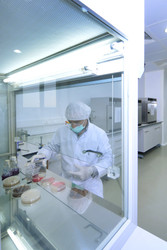Selecting the Right Shield: How to Choose a Laboratory Fume Hood
17th Apr 2024
For many laboratories, fume hoods are the workhorses of safety. They provide a vital line of defense against hazardous chemicals, vapors, and dust, protecting researchers and the integrity of their experiments. But with a variety of fume hood options available, selecting the right one for your lab can feel daunting. Worry not, intrepid scientists! This guide will equip you with the knowledge to choose the perfect fume hood for your specific needs.
Safety First: The Core Function of Fume Hoods
Fume hoods work by creating a negative pressure environment within the hood's enclosure. Airflow is constantly drawn in through the front sash opening and exhausted through a ventilation system, preventing hazardous fumes from escaping into the lab. This controlled airflow is paramount for protecting personnel from harmful exposures.
Know Your Enemy: Identifying Chemical Hazards
The first step in choosing a fume hood is understanding the types of chemicals you'll be working with. Here are key factors to consider:
- Toxicity: Highly toxic chemicals require a more robust fume hood system with increased airflow velocity to ensure complete capture of fumes.
- Volatility: Chemicals with high evaporation rates will release more vapors into the air, requiring a fume hood with a higher face velocity (the speed of air entering the hood) to effectively capture them.
- Reactivity: If you'll be working with chemicals that react violently with air or water, a specially designed fume hood with appropriate ventilation materials may be necessary.
Venting Options: Ducted vs. Ductless Fume Hoods
Fume hoods can be categorized based on their ventilation systems:
- Ducted Fume Hoods: These are the most common type and expel contaminated air to the outside environment through a ductwork system. They are ideal for working with highly toxic or volatile chemicals.
- Ductless Fume Hoods: These recirculate and filter the air within the lab instead of venting it outside. They are suitable for lower-risk applications but require proper maintenance and filter replacements to ensure effectiveness.
Finding the Perfect Fit: Size and Configuration
The size of your fume hood should accommodate your workflow and equipment. Consider:
- Work Area: Will you need space for large equipment or multiple users working simultaneously?
- Sash Height: Ensure the sash is high enough for you to comfortably work while maintaining proper containment.
- Storage Needs: Do you require built-in cabinetry or additional storage options within the fume hood?
Beyond the Basics: Additional Considerations
Several additional features can enhance your fume hood's functionality and safety:
- Airflow Monitors: These continuously measure the face velocity, ensuring proper containment.
- Service Fixtures: Gas, water, and electrical lines piped directly into the hood can streamline your workflow.
- Interior Construction Materials: Chemical-resistant materials like epoxy resin or polypropylene are crucial for withstanding harsh chemicals.
Consulting the Experts: Partnering with a Lab Supply Company
Selecting the right fume hood is an investment in safety and research efficiency. Partnering with a reputable lab supply company is highly recommended. Their expertise can guide you through the selection process, ensuring you choose a fume hood that meets your specific safety requirements and budgetary constraints.
Remember: Fume hoods are not one-size-fits-all solutions. By carefully considering the factors outlined above and consulting with a lab supply professional, you can choose the ideal fume hood for your laboratory, ensuring a safe and productive research environment.

